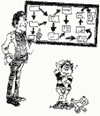ALTERNATIVES:
3.1. Create a reasonable project timeline for all Design-Build events so you begin to distinguish when your project will actually be completed from when you'd like it to be completed including ample time for the entire Design-Build process from inception of the first schema to the final punch list. Refer to Petrucci's Residential Contracting. This is a means to be realistic about your current commitments before embarking on your home building or remodeling project!
REFINEMENT:
3.2. Create an "Activity Flow Chart" to identify major events and support activities. Since this flowchart will be organized chronologically, consider this an informal, rough draft of a project schedule. Most important, this is an opportunity to better understand how activities relate to one another, and begin to get a sense of interdependencies. Write key questions on the flow chart as a reminder of issues of importance! Rely on members of your project team to assist you in the development of your flow chart. Familiarize yourself with Rogers’ Basic Construction Management: The Superintendent’s Job.
DOCUMENTATION:
3.3. Discuss project requirements with "friendly" designers, contractors, and suppliers. As you continue to update the "Activity Flow Chart" there will be supplemental information that augments major events and support activities. Refine your understanding of workflow by noting activity interdependence. Get a sense of how professional managers handle these concerns by paging through Cleland's Project Management Handbook.
NEGOTIATION:
3.4. Establish a project schedule using a Bar Chart. The chart will indicate major construction activities plotted on a weekly time scale; however, your project may require less or more time depending on scope of work to be performed, and you'll probably customize the chart as you move forward. If you've done your homework with the "Activity Flow Chart," you'll have a basic understanding of event sequence and duration for each phase of construction of your project. Most important, remain in sequence and communicate honestly and frequently with trade contractors and suppliers so they understand your time requirements. Refer to Love’s Bar Chart Scheduling for Residential Construction.
MANAGEMENT:
3.5. Anticipate construction activities and key events by referring to your "Bar Chart" and "Activity Flow Chart." These sources of information will prompt you to think weeks ahead when ordering products and materials from suppliers, as well as scheduling a Specialty Contractor's arrival on site, or better understanding what’s being accomplished by the General Contractor. Factors that typically affect coordination and control are site logistics, weather conditions, trade contractor availability, and material delivery. Be known as a great communicator! Review Haasl’s Production Checklist for Builders and Superintendents.
DILIGENCE:
3.6. Prior to project completion, contact a moving service to schedule transportation of your existing furniture and furnishings to your new home. Any newly purchased items should be stored at the distributor's warehouse so arrange delivery of these items at the same time.
FOLLOW-UP:
3.7. Create a maintenance schedule for products in your new home requiring future service. Store "Activity Flow Chart" and "Bar Chart" in the "Cardboard Box Files."
FURTHER READING:
You need to assign a fixed date and time for architecture and construction activities.
 Do you understand the difference between your expectations and the way things really happen?
Do you understand the difference between your expectations and the way things really happen?
Our "bar chart" model helps you visualize project sequence and the flow of work activities.
Benefit from 37 key questions for creating a "Schedule" Action Plan!
 Part of a consumer advocate's job is presenting the basics of better buying and selling. We look for information about products and services and the people who provide them to consumers.
Part of a consumer advocate's job is presenting the basics of better buying and selling. We look for information about products and services and the people who provide them to consumers.
Our goal is to inform, enlighten and educate both consumers and the businesses they frequent about their mutual problems and concerns.
The bottom line is helping people -- both those who buy and those who sell.
BIBLIOGRAPHY:
Cleland, David. Project Management Handbook.
New York: Wiley, 1988. (The Bible of Project Management)
Haasl, John. Production Checklist for Builders and Superintendents.
D.C.: Home Builder Press, 1997, 2000 3rd.
Love, Tom. Bar Chart Scheduling for Residential Construction.
D.C.: Home Builder Press, 1997.
Petrucci, Luigina. Residential Contracting.
New York: McGraw-Hill, 1995.
Rogers, Leon. Basic Construction Management: The Superintendent’s Job.
D.C.: Home Builder Press, 1999.